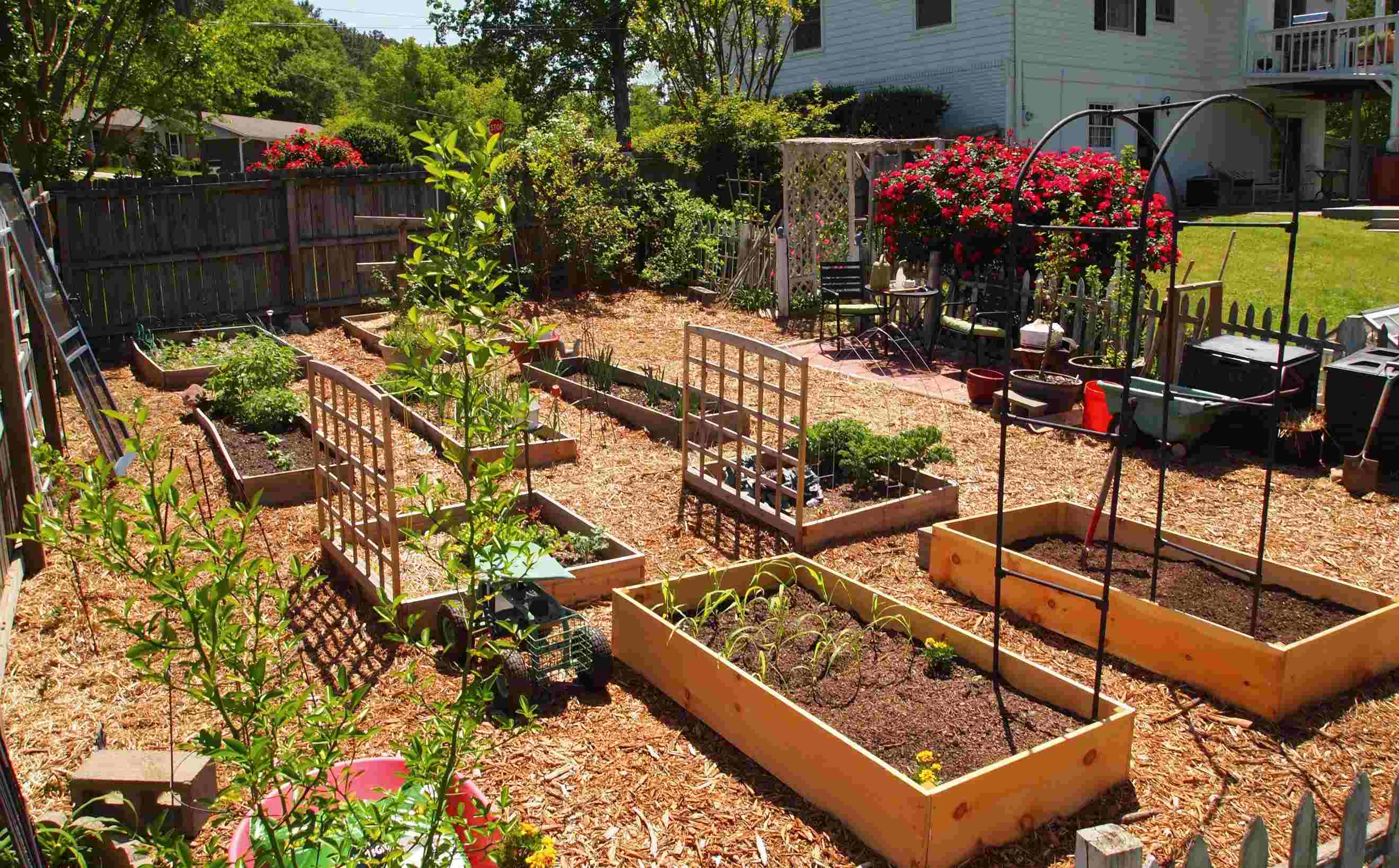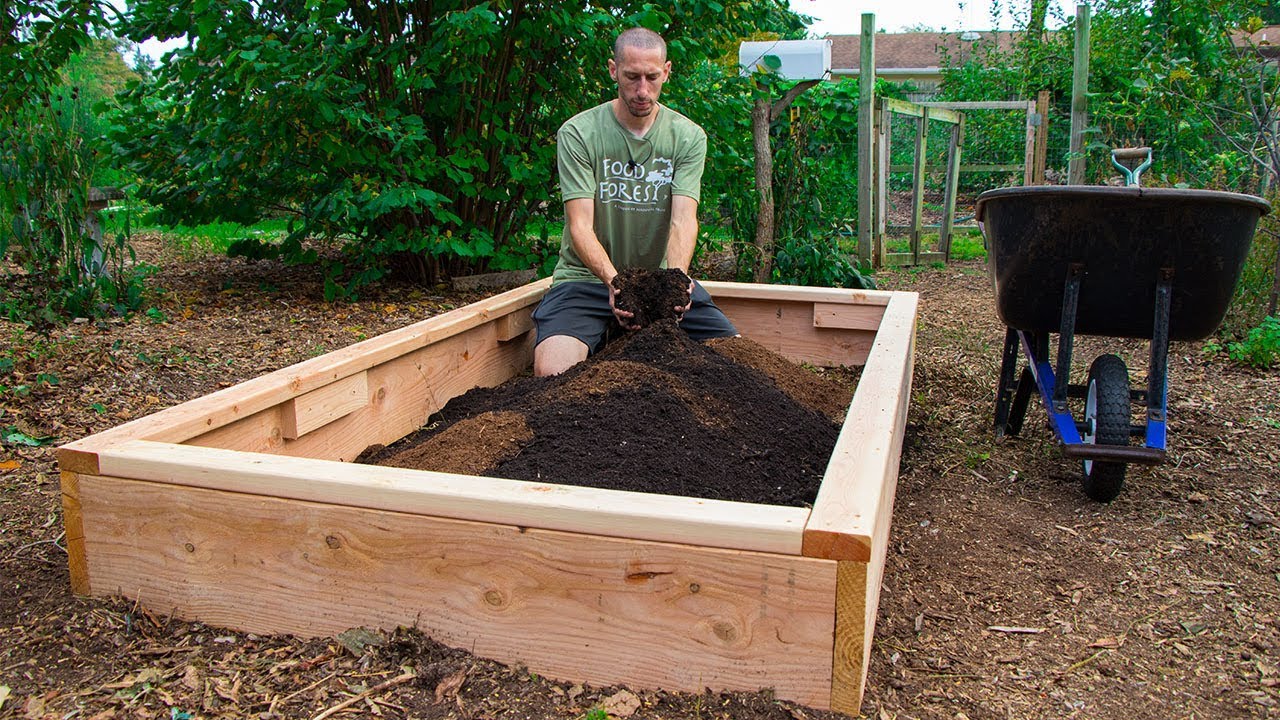Home>Garden Design>How To Make A Vegetable Garden In The Backyard


Garden Design
How To Make A Vegetable Garden In The Backyard
Modified: January 22, 2024
Learn how to plan and create your own vegetable garden in your backyard with our step-by-step guide. Start planning your garden today and enjoy fresh, homegrown produce all season long.
(Many of the links in this article redirect to a specific reviewed product. Your purchase of these products through affiliate links helps to generate commission for Chicagolandgardening.com, at no extra cost. Learn more)
Table of Contents
- Introduction
- Step 1: Choosing the Right Location
- Step 2: Clearing the Area and Preparing the Soil
- Step 3: Planning and Designing the Layout
- Step 4: Selecting the Vegetables to Grow
- Step 5: Planting the Vegetable Garden
- Step 6: Watering and Maintaining the Garden
- Step 7: Dealing with Pests and Diseases
- Step 8: Harvesting and Enjoying Your Homegrown Vegetables
- Conclusion
Introduction
Creating your own vegetable garden in the backyard is a rewarding and fulfilling endeavor. Not only does it provide you with a source of fresh, organic produce, but it also allows you to connect with nature and experience the joy of growing your own food. Whether you have a small patch of land or a larger space, planning and executing a vegetable garden requires careful consideration and preparation.
In this guide, we will take you through the process of planning and creating your own vegetable garden step by step. From choosing the right location to harvesting your homegrown vegetables, we will provide you with all the information you need to get started.
Before you begin, it’s important to note that starting a vegetable garden requires some initial investment of time, effort, and resources. However, the benefits far outweigh the challenges. Not only will you have a regular supply of fresh and nutritious vegetables, but you will also enjoy the physical activity, stress relief, and the satisfaction that comes from growing your own food.
Whether you’re a seasoned gardener or a beginner, this guide will help you get started on your vegetable gardening journey. So grab your gardening tools and let’s dive in!
Step 1: Choosing the Right Location
Choosing the right location for your vegetable garden is crucial for its success. Here are some factors to consider when selecting the perfect spot:
- Sunlight: Most vegetables thrive in full sun, which means they need at least 6-8 hours of direct sunlight each day. Look for an area in your backyard that receives ample sunlight.
- Soil Quality: The soil should be well-draining and rich in nutrients. Avoid areas with compacted soil or heavy clay as they can hinder plant growth. Conduct a soil test to determine its pH level and fertility. You can make amendments to improve the soil quality if needed.
- Proximity to Water Source: Your vegetable garden should be close to a water source for easy irrigation. Consider the availability of a hose or a nearby water spigot.
- Accessibility: Ensure that the location is easily accessible for regular maintenance tasks such as watering, weeding, and harvesting. A garden that is too far away or difficult to reach may discourage you from taking proper care of your plants.
- Protection from Elements: Consider the surrounding elements that may affect your garden, such as strong winds, frost pockets, or excessive shade from nearby structures or trees. Shelter your vegetable garden from these elements to prevent damage to your plants.
Once you have evaluated these factors, identify a suitable area in your backyard that meets the requirements. It could be a raised bed, a dedicated plot, or even containers if you have limited space.
Remember, the location you choose will have a significant impact on the overall health and productivity of your vegetable garden. Take the time to assess and analyze the different areas of your backyard to find the ideal spot.
Step 2: Clearing the Area and Preparing the Soil
Before you start planting your vegetable garden, it’s crucial to clear the area of any obstructions and prepare the soil for optimal growth. Here are the steps to follow:
- Remove weeds and debris: Begin by removing any weeds, rocks, or other debris from the chosen area. Weeds compete with your vegetable plants for nutrients and sunlight, so it’s important to eliminate them.
- Clear the sod: If the area is covered with grass, you can either dig it up or use a sod cutter to remove the top layer. This step is essential to prevent the grass from overtaking your vegetable plants.
- Loosen the soil: Use a garden fork or tiller to loosen the soil to a depth of about 8-12 inches. This helps improve drainage, allows roots to penetrate easily, and enhances overall soil structure.
- Amend the soil: Test the soil pH and fertility levels and make appropriate amendments based on the results. Add organic matter such as compost, well-rotted manure, or peat moss to enrich the soil’s nutrient content and improve its texture.
- Remove large rocks and clumps: While loosening the soil, remove any large rocks, clumps, or roots that may hinder root growth or impede proper planting.
Once you have completed these steps, your soil will be ready for planting. Proper soil preparation is key to providing your vegetable plants with a healthy growing environment and setting them up for success. Remember to regularly maintain and enrich the soil throughout the growing season to ensure optimum plant growth and production.
Step 3: Planning and Designing the Layout
Planning and designing the layout of your vegetable garden is an important step that helps maximize space, optimize plant growth, and create an organized and visually appealing garden. Here’s how you can plan and design your garden layout:
- Consider plant spacing: Different vegetables have varying spacing requirements. Take note of the recommended spacing for each vegetable and plan accordingly. This will ensure that your plants have enough room to grow and receive adequate sunlight and airflow.
- Group companion plants together: Some plants thrive when planted together, while others may hinder each other’s growth. Research companion planting and group compatible plants together to promote healthy growth and natural pest control.
- Create pathways: Designate pathways between garden beds to provide easy access for maintenance tasks and harvesting. Paths also help prevent soil compaction by providing a designated area for foot traffic.
- Consider vertical gardening: If you have limited space, consider incorporating vertical gardening techniques such as trellises, cages, or stakes. This allows you to grow vining plants, such as tomatoes or cucumbers, vertically, saving space and adding visual interest to your garden.
- Account for sunlight: When planning the layout, consider the sun’s path throughout the day and position taller plants or structures in a way that will not shade smaller plants.
- Plan for succession planting: To maximize your harvest, plan for succession planting. This involves planting new crops as soon as previous ones are harvested to ensure a continuous supply throughout the growing season.
Sketch out your garden layout on paper or use online garden planning tools to visualize your design before implementing it. By carefully considering your plant spacing, companion planting, pathways, vertical gardening, sunlight, and succession planting, you can create a well-organized and efficient vegetable garden that optimizes space and promotes plant health.
Step 4: Selecting the Vegetables to Grow
Choosing the right vegetables to grow in your garden is an exciting and essential step in the planning process. Consider the following factors when selecting vegetables:
- Climate and Hardiness Zone: Determine your hardiness zone, which will help you identify the types of vegetables that thrive in your specific region. Consider the average frost dates and temperature ranges to ensure you choose vegetables that can adapt to your climate.
- Your Preferences and Diet: Take into account your personal preferences and dietary needs. Consider the vegetables you and your family enjoy eating the most, as well as any dietary restrictions or specific nutritional requirements.
- Space and Time: Consider the available space and time you have for gardening. If you have limited space, focus on compact or vertical-growing vegetables. Additionally, choose vegetables that align with the time you can dedicate to maintenance and harvesting.
- Success Rate: Research the success rate of different vegetables in your area. Some vegetables are easier to grow and generally have higher yields, making them more suitable for beginners.
- Companion Planting: Take into account the concept of companion planting when choosing vegetables. Select plants that complement each other and have beneficial relationships, such as deterring pests or enhancing flavor.
Consider a mix of cool-season and warm-season vegetables to extend your harvest throughout the year. It’s also a good idea to try some lesser-known or heirloom varieties to add diversity to your garden and explore new flavors.
Ultimately, the selection of vegetables is a personal choice, so choose varieties that align with your preferences, skills, and available resources. It’s important to have a good balance of crops to enjoy a variety of flavors, harvests, and gardening experiences.
Step 5: Planting the Vegetable Garden
After all the planning and preparation, it’s finally time to start planting your vegetable garden. Here are the steps to follow:
- Refer to planting guides: Consult planting guides or seed packets for specific instructions on planting depth, spacing, and timing for each vegetable. This information will help you ensure proper planting and give your plants the best chance of success.
- Prepare planting holes or furrows: Use a trowel, shovel, or your hands to create planting holes or furrows according to the recommended spacing for each vegetable. Make sure the holes or furrows are deep enough to accommodate the root system of the plants.
- Plant the seeds or seedlings: Gently place the seeds into the holes at the appropriate depth, or carefully transplant seedlings into the furrows, making sure to cover the roots adequately with soil.
- Water thoroughly: After planting, give your newly planted vegetables a good soak to promote proper root establishment. Water them gently but thoroughly to ensure the soil is moist and evenly distributed.
- Add mulch: Apply a layer of organic mulch, such as straw or wood chips, around the plants. This helps retain moisture, suppress weeds, and regulate soil temperature.
- Support vining plants: If you’re growing vining plants like tomatoes or cucumbers, provide support such as stakes, trellises, or cages to help them grow vertically and prevent sprawling.
- Monitor and maintain: Regularly monitor your vegetable garden for any signs of pests, diseases, or nutrient deficiencies. Keep the garden well-watered, weed-free, and fertilize as needed to ensure healthy growth.
Remember to follow the specific planting requirements for each vegetable, as they may differ based on their individual needs. Providing the right conditions and care from the start will give your vegetables the best chance to thrive and produce an abundant harvest.
As your vegetable garden grows, continue to monitor its progress, adjust watering and maintenance practices, and harvest your crops at the appropriate time. The joy of growing your own vegetables and reaping the rewards of your hard work will be a satisfying experience throughout the season.
Step 6: Watering and Maintaining the Garden
Proper watering and maintenance are essential for the health and productivity of your vegetable garden. Here are the key steps to follow:
- Watering: Provide your vegetable garden with consistent and adequate water. Most vegetables require about 1-2 inches of water per week, either through rainfall or irrigation. Water deeply and at the base of the plants to encourage deep root growth. Avoid overhead watering, which can lead to foliar diseases.
- Monitoring soil moisture: Regularly check the soil moisture level by sticking your finger into the soil. If it feels dry at a depth of 1-2 inches, it’s time to water. Adjust your watering schedule based on the weather conditions, as hot and dry periods may require more frequent watering.
- Weeding: Keep your vegetable garden free from weeds that compete with your plants for nutrients, water, and sunlight. Regularly inspect and remove any weeds by hand or with the help of garden tools.
- Feeding: Fertilize your plants regularly with organic compost, well-rotted manure, or balanced organic fertilizers. This provides essential nutrients to support healthy growth and productivity. Follow the recommended fertilizer application rates for each type of vegetable.
- Pruning and training: Some vegetables, such as tomatoes or squash, may benefit from pruning or training to improve airflow, reduce disease risks, and promote better fruit development. Consult specific pruning techniques for each vegetable to ensure proper care.
- Pest and disease management: Regularly inspect your plants for any signs of pests or diseases. Practice integrated pest management techniques such as handpicking pests, using organic pest control methods, or introducing beneficial insects to manage pest populations.
- Supporting plants: Provide support structures such as stakes, trellises, or cages for plants that need it, like beans, peas, or cucumbers. This helps prevent plants from sprawling, improves airflow, and makes harvesting easier.
Consistency and attentiveness are key when it comes to watering and maintaining your vegetable garden. By providing the right amount of water, controlling weeds, providing nutrients, managing pests and diseases, and providing support when necessary, you’ll create an environment that encourages healthy growth and maximizes your garden’s potential.
Regular monitoring and timely intervention will help you address any issues promptly, ensuring that your vegetable garden thrives throughout the growing season.
Step 7: Dealing with Pests and Diseases
Dealing with pests and diseases is a crucial part of maintaining a healthy vegetable garden. Here are the steps you can take to manage common pests and diseases:
- Identify the problem: Regularly inspect your plants for any signs of pests or diseases. Look for chewed leaves, wilting, discoloration, or any abnormal growth. Identifying the problem early allows for timely intervention.
- Practice good garden hygiene: Practice good sanitation by clearing away plant debris and fallen leaves. Remove any diseased plants and dispose of them properly to prevent the spread of diseases.
- Handpick pests: For larger insects like caterpillars or slugs, handpicking and removing them manually can be an effective control method. Drop them into a bucket of soapy water to ensure they don’t return.
- Use organic pest control methods: Utilize organic pest control methods such as neem oil, insecticidal soaps, or homemade remedies like garlic spray or chili pepper spray to deter pests.
- Encourage beneficial insects: Attract beneficial insects to your garden, such as ladybugs, lacewings, or bees, which can help control pests naturally. Plant flowers and herbs that attract these helpful insects.
- Rotate crops: Practice crop rotation to prevent the buildup of pests and diseases in the soil. By not planting the same vegetable family in the same spot year after year, you can interrupt pest and disease life cycles.
- Monitor for disease-resistant varieties: When selecting vegetable varieties, choose disease-resistant types whenever possible. These varieties have been bred to withstand specific diseases, reducing the risk of infection.
- Consider barriers and protective covers: Use physical barriers like netting or row covers to protect your plants from pests, such as birds or insects. These covers allow sunlight and water to pass through while keeping pests at bay.
- Consult gardening resources: If you are unsure about specific pests or diseases affecting your plants, consult gardening books, online resources, or local gardening experts for advice and solutions tailored to your region.
Remember, prevention is key when it comes to managing pests and diseases. Regularly inspect your garden, implement preventative measures, and take action as soon as you notice any problems. By being proactive, you can minimize the impact of pests and diseases and maintain a healthy vegetable garden.
Step 8: Harvesting and Enjoying Your Homegrown Vegetables
After all your hard work and patience, it’s time to reap the rewards of your vegetable garden by harvesting and enjoying the fruits (or vegetables) of your labor. Here are some tips to make the most of your harvest:
- Know the right time: Refer to seed packets or gardening resources to determine the optimal time for harvesting each vegetable. Different vegetables have different signs of readiness, such as color, size, or texture.
- Use sharp tools: Use sharp garden shears, scissors, or a knife to harvest your vegetables. This helps avoid damage to the plants and ensures clean cuts.
- Harvest in the morning: For leafy greens and herbs, harvest in the early morning while the plants are still crisp and fresh. This is when the moisture levels are highest, resulting in better flavor and quality.
- Indulge in freshness: Enjoy the taste of freshly harvested vegetables by incorporating them into your meals as soon as possible. Whether it’s a salad, stir-fry, or grilled veggies, savor the flavors of your homegrown produce.
- Share with others: If you have an abundance of vegetables, consider sharing your harvest with friends, family, or neighbors. It’s a great way to spread the joy of homegrown produce and build stronger connections in your community.
- Preserve the surplus: If you have more vegetables than you can consume, explore different preservation methods such as canning, freezing, or pickling to enjoy your harvest throughout the year.
- Save seeds: If you’re growing heirloom or open-pollinated varieties, save the seeds from your best plants for future seasons. This allows you to maintain the traits you love and continue the cycle of growing your own food.
- Reflect and learn: Take time to reflect on your gardening experience, noting what worked well and what you could improve upon. This helps you learn and grow as a gardener, making each season more successful than the last.
Remember, the joy of gardening extends beyond the act of planting and harvesting. It’s about connecting with nature, appreciating the magic of growth, and nourishing your body and soul with fresh, homegrown vegetables. So celebrate your hard work, invite others to join in, and relish in the satisfaction of enjoying your own delicious harvest.
Conclusion
Creating and maintaining a vegetable garden in your backyard can be a fulfilling and rewarding experience. From the initial planning stages to the final harvest, every step of the process is filled with opportunities to connect with nature, savor the flavors of homegrown produce, and enjoy the satisfaction of self-sufficiency.
By choosing the right location, preparing the soil, planning the layout, selecting suitable vegetables, and providing proper care, you can create a thriving vegetable garden that produces a bountiful harvest. Along the way, you will encounter challenges like pests, diseases, and occasional setbacks, but with patience and perseverance, you can overcome them and continue to enjoy the fruits of your labor.
Gardening is a continuous learning journey. Each season presents new lessons, insights, and opportunities for growth. As you gain experience, you will become more attuned to the needs of your plants, develop your own techniques and preferences, and discover the joy of experimenting with different varieties and planting methods.
Beyond the practical benefits of having a homegrown vegetable garden, there are countless intangible rewards. Gardening provides a sanctuary for relaxation, a space for mindfulness, and an opportunity to foster a deeper connection with the natural world. It offers a sense of accomplishment and self-sustainability as you witness the transformation from seed to harvest.
So, whether you have a small patch of land or a larger backyard, take the plunge and start planning your vegetable garden. Embrace the challenges, enjoy the process, and cherish the abundance of fresh, flavorful, and nutritious vegetables that you can proudly call your own.
Remember, your vegetable garden is a testament to your dedication, perseverance, and love for nature. So, grab your gardening tools, roll up your sleeves, and let the journey begin!










